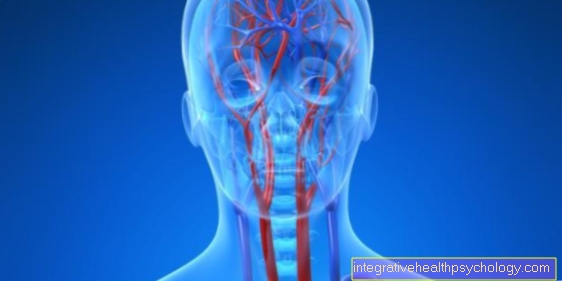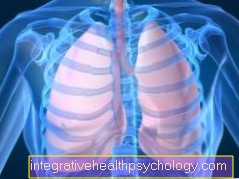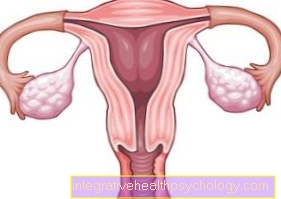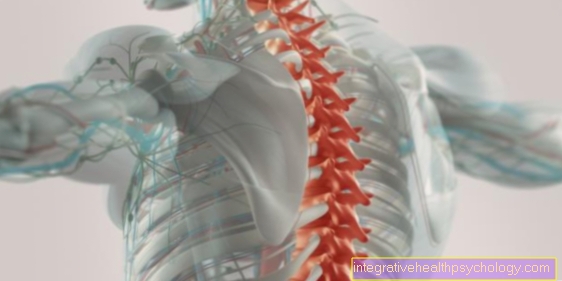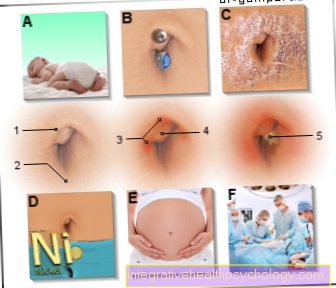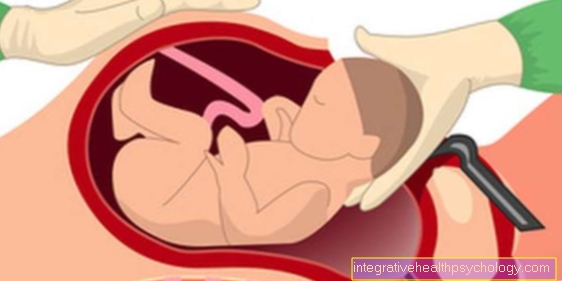Nephrotic Syndrome
definition
The nephrotic syndrome describes a clinical picture that arises due to damage to the kidney. The existing damage leads to increased excretion of proteins in the urine (at least 3.5 g per day). This means that there are fewer proteins in the blood that can bind water. This creates water retention in the body. In addition, the level of fats in the blood is increased.
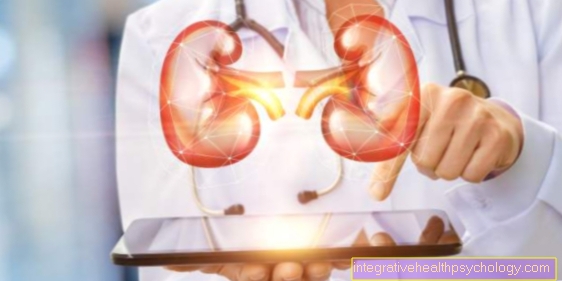
causes
The nephrotic syndrome can result from various kidney diseases. There are some diseases that affect the kidney corpuscle, the glomerulus. This is responsible for filtering water and many other substances that should be excreted in the urine. The resulting urine is then transported through the ureters into the bladder. In healthy people, the kidney corpuscles allow only very small particles to pass through their filter. However, if you suffer from an inflammation called glomerulonephritis, for example, the filter can be damaged. This means that larger substances such as proteins can now also be excreted. As a result, there is a shortage of proteins in the blood. Albumin, the most abundant protein in the blood, is particularly important for binding water.
Read more on the topic: Glomerulonephritis
If there is a lack of protein in the blood due to damage to the kidneys, the water can no longer be held in the vessels and water is retained. The loss of function of the kidney corpuscles described can also result from deposits of harmful substances. In the case of diabetes mellitus, too, an increased sugar level in the blood over a long period of time can lead to deposits in the kidneys and thus to damage to the filter.
Concomitant symptoms
Concomitant symptoms that often occur include water retention (edema) and high blood pressure. In addition, the proportion of fats and cholesterol in the blood predominates. Furthermore, when urinating, foamy urine often appears due to the high protein content. This foam is usually so stable that it is not only visible when it hits the water in the toilet and then bursts, but remains on the water like a foamy blanket.
A protein that is important for preventing blood clotting is also lost in the urine. It's called antithrombin III and it works by preventing platelets from sticking together. If there is a deficiency of antithrombin III in the nephrotic syndrome, blood clots and thromboses are more likely to form.
Read more on the topic: Detect thrombosis
Another accompanying symptom is the increased susceptibility to infectious diseases. This occurs because the antibodies in the blood, which are also proteins, are lost. They are responsible for the defense against pathogens and activate the immune system. A lack of antibodies therefore reduces the body's protection against diseases.
In addition, more calcium is excreted in nephrotic syndrome, as this is normally bound to proteins in the blood. The reduced calcium can bring accompanying symptoms of diarrhea, hair and nail changes to cardiac arrhythmias.
Edema
Water retention in the tissue is called edema. In nephrotic syndrome, they occur as a result of the lack of protein in the blood. Proteins are also called proteins and are negatively charged molecules that attract water due to their chemical properties. Hence they are called osmotically effective particles. If some of the proteins are missing in the blood, the osmotic pressure is reduced. As a result, the water can no longer be held and escapes from the vessels. Water accumulates in the body, which is known as protein deficiency edema.
Find out more about the topic: Protein deficiency edema
hypertension
One speaks of hypertension from a value of over 140 / 90mmHg. The volume of blood that is in the blood vessels is decisive for blood pressure. You can think of it as a rubber tube, if more liquid is pressed into it, the pressure inside increases. If the kidney is damaged so severely in a nephrotic syndrome that only little or no water can be excreted, it will collect in the body. As a result, there is more fluid in the blood vessels and the result is increased blood pressure.
You can read everything about high blood pressure here: high blood pressure
Hypercholisterinemia
The lack of protein in the blood caused by nephrotic syndrome is very dangerous for the body. Therefore, it reproduces many proteins, only the larger ones are not excreted and thus accumulate. These include, for example, lipoproteins. They are responsible for binding cholesterol and transporting it in the blood. An increased lipoprotein concentration also increases the cholesterol level in the blood and leads to hypercholesterolemia.
You can find detailed information on this topic under: Hypercholisterinemia
treatment
In the causal therapy, glucocorticoids or more potent drugs are usually used. They inhibit inflammatory processes and should therefore avoid further damage to the kidney as far as possible. If the symptom is high blood pressure, antihypertensive drugs such as ACE inhibitors or sartans are used. If the water excretion is severely reduced or if there is water retention in the body, diuretics can be taken, which promote the water excretion and flush the water out of the body.
Statins are used as therapy for hypercholesterolemia.
In the case of nephrotic syndrome, thrombosis prophylaxis in the form of oral anticoagulants (anticoagulants) is often important. In this case, heparin should not be given because its effect is based on the activation of antithrombin III and it would therefore be ineffective in the present deficiency.
When should cortisone be taken?
Cortisone belongs to the group of glucocorticoids. These are particularly responsible in the body for inhibiting inflammatory processes. So if the cause of the nephrotic syndrome is a disease that causes inflammation, cortisone can be used for therapy
You can read more about this topic at: Cortisone
homeopathy
Homeopathy is based on the fact that an effective or even toxic substance is extremely diluted. Through various dilution processes, only the desired effect should remain. However, this idea contradicts the current state of science and the effect of the individual substances could not be proven. Therefore, an exclusive homeopathic therapy should never be carried out. Since homeopathy does improve some patents, it can be carried out by a doctor in addition to medical therapy. Homeopathy is mostly used to treat nephrotic syndrome when the cause is an autoimmune disease.
What should be considered in nutrition?
With nephrotic syndrome, there are a few dietary considerations. For one, you shouldn't eat too much protein. Since the pores of the filter in the kidney are enlarged, more proteins are excreted. However, these can also get stuck and block the rest of the kidney's drainage system. This can cause further damage to the kidney. However, enough protein should still be eaten to avoid pronounced malnutrition. A protein intake of around 1.4g of protein per kg of body weight per day makes sense for this. On the other hand, not so much salt should be excluded from the diet. This binds more water in the body and thus promotes water retention and high blood pressure. Therefore, if possible, only 6g of table salt should be consumed during the day through food and drinks.
Special features in children
In children, unlike adults, nephrotic syndrome occurs in 90% of cases not as the cause of another disease, but rather primarily. This is usually the so-called minimal change glomerulonephritis. It often begins in children three to six years of age for no known cause. Damage to the kidney corpuscle causes an increase in protein (at least 3g / day) to be excreted in the urine. This leads to a protein deficiency in the blood which manifests itself in the form of water retention. These occur especially in front of the ankles, on the shins and on the eyelids.
Find out more about this topic at: Forms of glomerulonephritis
The affected child usually does not feel sick, but gains weight quickly due to the water retention. Minimal change glomerulonephritis in children can be treated with glucocorticoids, which have an anti-inflammatory effect like cortisone. For this, the glucocorticoid prednisone is taken at a dosage of 1 mg / kg body weight for up to two months. In the remaining 10% of cases, nephrotic syndrome occurs in children as a result of another disease. This can be, for example, congenital autoimmune diseases such as systemic lupus erythematosus or IgA nephritis. Here the underlying disease is treated.
Duration / prognosis - is a nephrotic syndrome curable?
The duration and prognosis of nephrotic syndrome depend on the existing underlying disease and the time of the first diagnosis of nephrotic syndrome. In children, minimal change glomerulonephritis most often leads to nephrotic syndrome. If it is the cause, the prognosis is very good in most cases. If the children are treated with glucocorticoids, the nephrotic syndrome can be cured in 90% of the sick.
In adults, the underlying diseases are very different. For example, nephrotic syndrome can occur as a sequela of diabetes that has been poorly controlled for a long time. If the damage is detected early on, the monitoring and control of blood sugar must be optimized. This can result in a good prognosis for the patient. If an autoimmune disease was detected late, the prognosis is worse. The kidney is so severely damaged by the underlying disease that it continues to lose its function without the right therapy. Kidney failure can occur. These patients then have to replace the kidney's lost detoxification and excretory functions with dialysis or a kidney transplant.
Read more on the topic: Acute kidney failure
Course of a nephrotic syndrome
The course always depends on the individual patient. A good response to therapy can bring about improvement or healing. However, if the patient does not respond to the therapy, the destruction of the kidney continues. The symptoms worsen or even kidney failure occurs, which is noticeable in the fact that no more urine is excreted. Renal vein thrombosis can also occur as a complication in the course of the nephrotic syndrome. This is caused by the loss of proteins through the kidneys that prevent blood cells from attaching to one another. Without these proteins, the blood cells stick to each other and to the vessel walls. The clogging of the vessels is called thrombosis. This leads to a build-up of blood back into the kidney, which can rupture and cause further damage.
diagnosis
The diagnosis of nephrotic syndrome is made by examining the blood and urine. In nephrotic syndrome, the increased excretion of proteins increases the amount of protein in the urine (at least 3.5 g / day) and decreases it in the blood. The urine is collected for a day and the total amount of proteins it contains is determined. The amount of proteins and the composition of the individual proteins in the blood is determined by means of electrophoresis. It is also possible to diagnose the underlying disease of the kidney with the ultrasound or by taking a sample from the kidney.
Electrophoresis
In electrophoresis, a mixture of substances is separated in an electric field. When electricity is applied, the substances migrate at different speeds depending on their charge, i.e. different distances within a certain time. In this way you can also separate a protein mixture from the blood and thus recognize how much of which protein is present in the blood.

